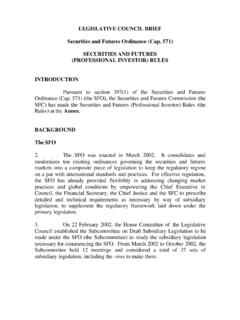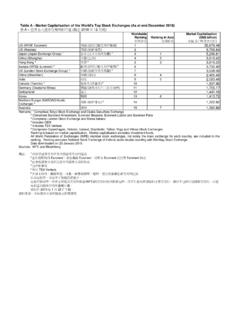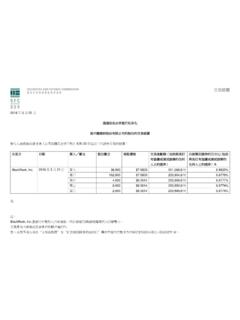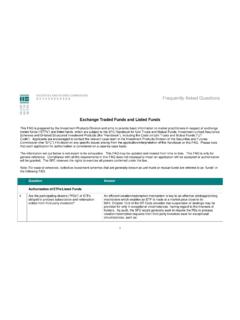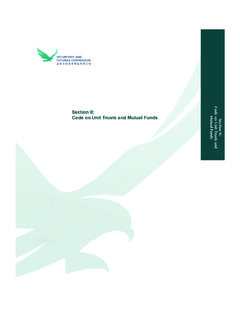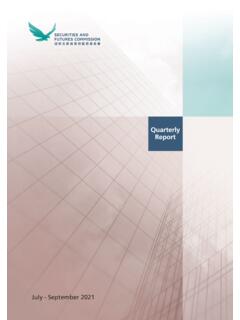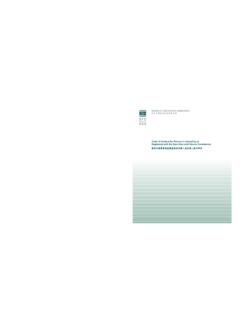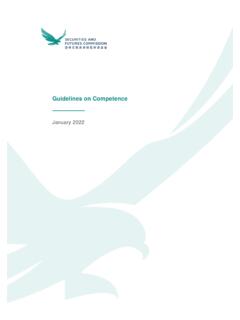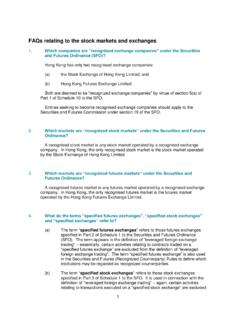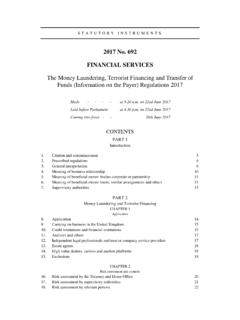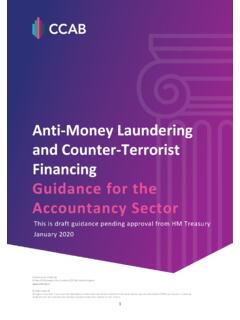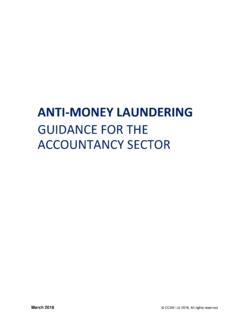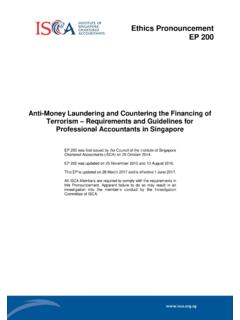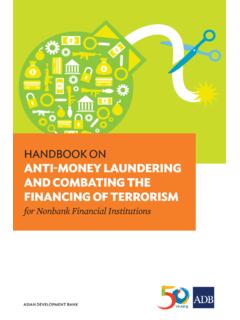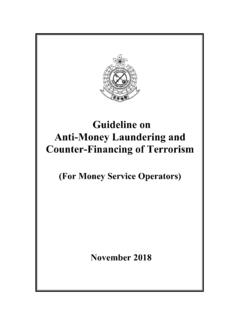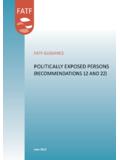Transcription of Guideline on Anti-Money Laundering and Counter- …
1 Guideline on Anti-Money Laundering and Counter- Financing of Terrorism (For Licensed Corporations) November 2018 Securities & Futures Commission 2018 April 2012 first edition July 2012 second edition April 2015 third edition March 2018 fourth edition November 2018 fifth edition Published by Securities and Futures Commission 35th Floor Cheung Kong Center 2 Queen s Road Central Hong Kong Tel : (852) 2231 1222 Fax : (852) 2521 7836 E-mail : SFC website : All rights reserved. No part of this publication may be reproduced, stored in a retrieval system, or transmitted in any form or by any means, electronic, mechanical, photocopying, recording or otherwise, without the prior written permission of the publisher. This Guideline supersedes all previous versions of this Guideline , which was formerly known as the Guideline on Anti-Money Laundering and Counter- Terrorist Financing.
2 Content Chapter 1 Overview .. 1 Chapter 2 AML/CFT systems .. 13 Chapter 3 Risk-based approach .. 21 Chapter 4 Customer due diligence .. 26 Chapter 5 Ongoing monitoring .. 77 Chapter 6 Terrorist financing, financial sanctions and proliferation financing .. 83 Chapter 7 Suspicious transaction reports and law enforcement requests .. 90 Chapter 8 Record-keeping .. 105 Chapter 9 Staff training .. 109 Chapter 10 Wire transfers .. 113 Appendix A Illustrative examples and further guidance .. 120 Appendix B Sample correspondence issued by the JFIU .. 127 Glossary of key terms and abbreviations .. 131 July 2012 1 Chapter 1 OVERVIEW Introduction This Guideline is published under section 7 of the Anti-Money Laundering and Counter- Terrorist Financing Ordinance, Cap.
3 615 (the AMLO), and section 399 of the Securities and Futures Ordinance, Cap. 571 (the SFO). Terms and abbreviations used in this Guideline shall be interpreted by reference to the definitions set out in the Glossary part of this Guideline . Where applicable, interpretation of other words or phrases should follow those set out in the AMLO or the SFO. Unless the context otherwise requires, the term financial institutions (FIs) refers to licensed corporations (LCs). This Guideline is issued by the Securities and Futures Commission (SFC) and sets out the relevant Anti-Money Laundering and Counter- financing of terrorism (AML/CFT) statutory and regulatory requirements, and the AML/CFT standards which LCs should meet in order to comply with the statutory requirements under the AMLO and the SFO.
4 Compliance with this Guideline is enforced through the AMLO and the SFO. LCs which fail to comply with this Guideline may be subject to disciplinary or other actions under the AMLO and/or the SFO for non-compliance with the relevant requirements. This Guideline is intended for use by FIs and their officers and staff. This Guideline also: (a) provides a general background on the subjects of money Laundering and terrorist financing (ML/TF), including a summary of the main provisions of the applicable AML/CFT legislation in Hong Kong; and (b) provides practical guidance to assist FIs and their July 2012 2 senior management in designing and implementing their own policies, procedures and controls in the relevant operational areas, taking into consideration their special circumstances so as to meet the relevant AML/CFT statutory and regulatory requirements.
5 In addition to the Guideline on Anti-Money Laundering and Counter- Financing of Terrorism (For Authorized Institutions) issued by the Hong Kong Monetary Authority (HKMA) for use by authorized institutions, registered institutions (RIs) are required to have regard to paragraph of this Guideline for the definition of customer for the securities, futures and leveraged foreign exchange businesses (hereinafter collectively referred to as securities sector or securities businesses ), and paragraphs and of this Guideline in identifying securities sector specific suspicious transactions. The relevance and usefulness of this Guideline will be kept under review and it may be necessary to issue amendments from time to time.
6 For the avoidance of doubt, the use of the word must or should in relation to an action, consideration or measure referred to in this Guideline indicates that it is a mandatory requirement. Given the significant differences that exist in the organisational and legal structures of different FIs as well as the nature and scope of the business activities conducted by them, there exists no single set of universally applicable implementation measures. The content of this Guideline is not intended to be an exhaustive list of the means of meeting the statutory and regulatory requirements. FIs therefore should use this Guideline as a basis to develop measures appropriate to their structure and business activities.
7 July 2012 3 This Guideline also provides guidance in relation to the operation of the provisions of Schedule 2 to the AMLO (Schedule 2). , AMLO, (6), SFO A failure by any person to comply with any provision of this Guideline does not by itself render the person liable to any judicial or other proceedings but, in any proceedings under the AMLO or the SFO before any court, this Guideline is admissible in evidence; and if any provision set out in this Guideline appears to the court to be relevant to any question arising in the proceedings, the provision must be taken into account in determining that question. In considering whether a person has contravened a provision of Schedule 2, the SFC must have regard to any relevant provision in this Guideline .
8 & 194, SFO In addition, a failure to comply with any of the requirements of this Guideline by LCs and (where applicable) licensed representatives may reflect adversely on their fitness and properness and may be considered to be misconduct. & 196, SFO Similarly, a failure to comply with any of the requirements of the Guideline on Anti-Money Laundering and Counter- Financing of Terrorism (For Authorized Institutions) issued by the HKMA for use by authorized institutions or to have regard to paragraphs , and of this Guideline by RIs may reflect adversely on their fitness and properness and may be considered to be misconduct.
9 The nature of money Laundering and terrorist financing , Sch. 1, AMLO The term money Laundering is defined in section 1 of Part 1 of Schedule 1 to the AMLO and means an act intended to have the effect of making any property: (a) that is the proceeds obtained from the commission of an indictable offence under the July 2012 4 laws of Hong Kong, or of any conduct which if it had occurred in Hong Kong would constitute an indictable offence under the laws of Hong Kong; or (b) that in whole or in part, directly or indirectly, represents such proceeds, not to appear to be or so represent such proceeds. There are three common stages in the Laundering of money , and they frequently involve numerous transactions.
10 An FI should be alert to any such sign for potential criminal activities. These stages are: (a) Placement - the physical disposal of cash proceeds derived from illegal activities; (b) Layering - separating illicit proceeds from their source by creating complex layers of financial transactions designed to disguise the source of the money , subvert the audit trail and provide anonymity; and (c) Integration - creating the impression of apparent legitimacy to criminally derived wealth. In situations where the layering process succeeds, integration schemes effectively return the laundered proceeds back into the general financial system and the proceeds appear to be the result of, or connected to, legitimate business activities.
